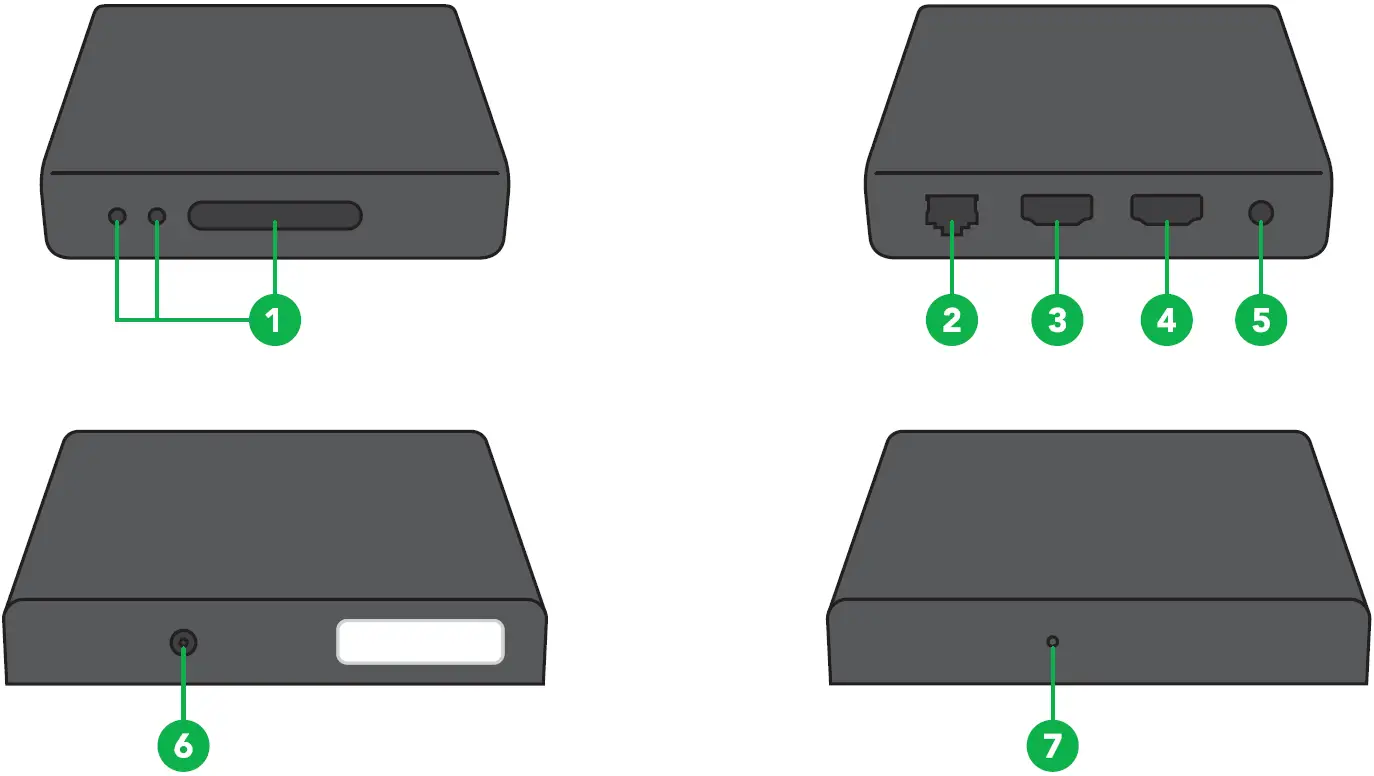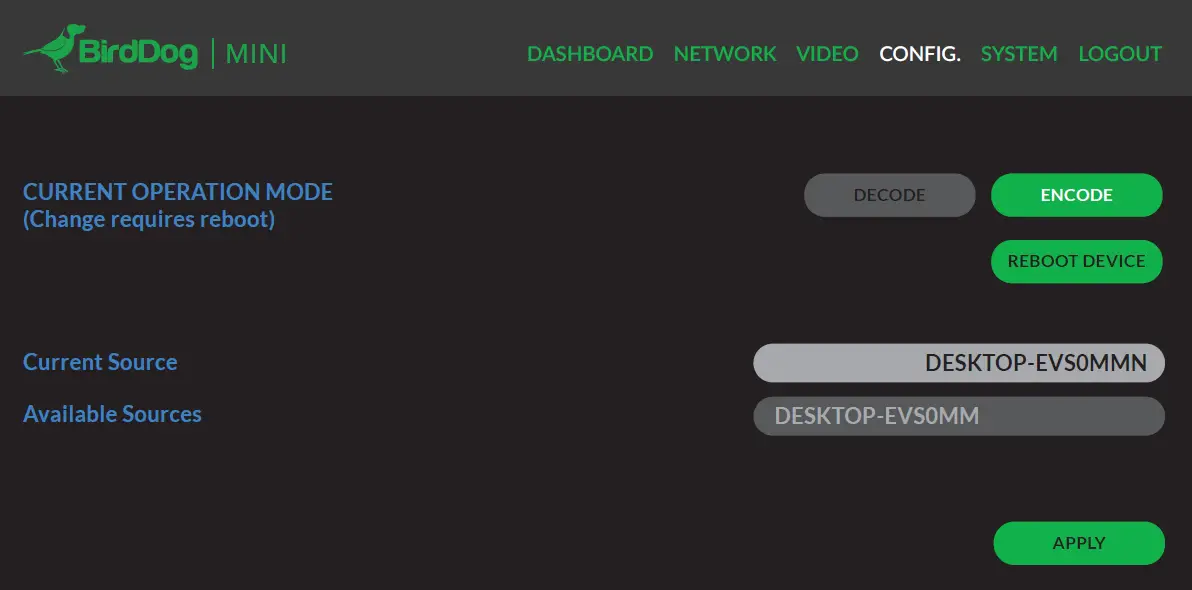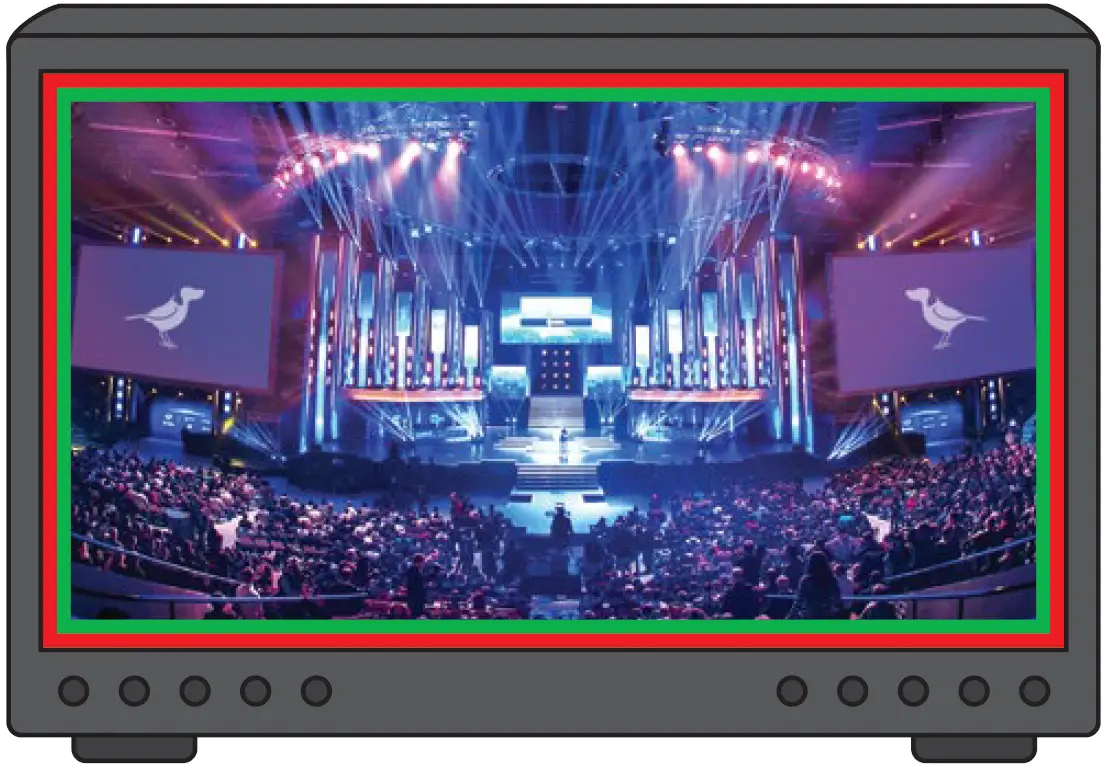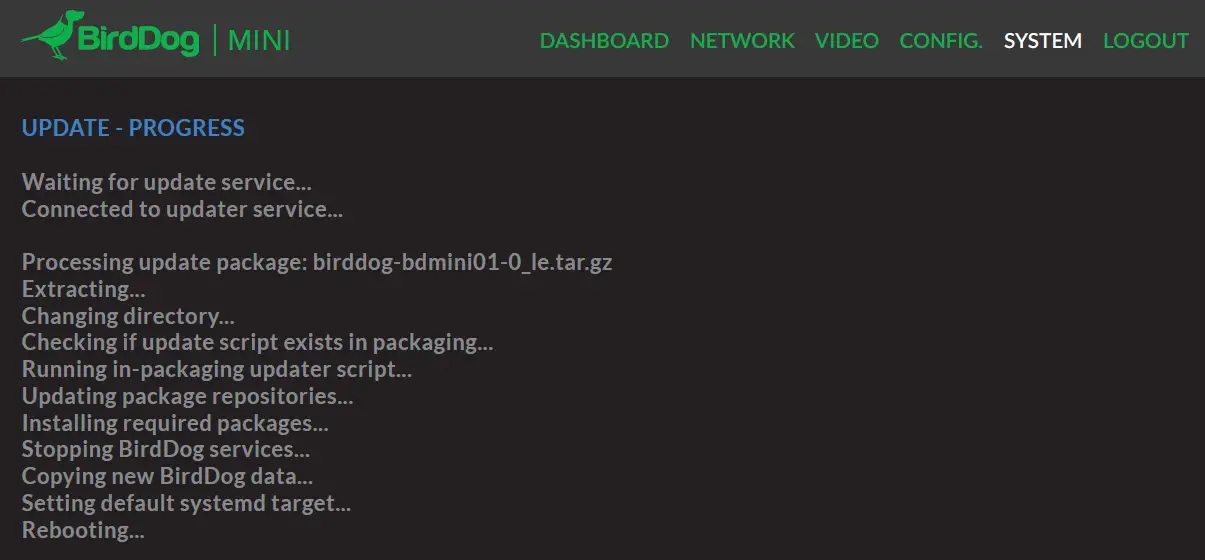NDI BirdDog MINI
GETTING TO KNOW MINI
Thanks for purchasing BirdDog Mini. Please take some time to read this document to allow you to get the most out of your purchase and familiarize yourself with the features available in the unit.
Physical Connectors

- LED Indicator
- 1Gb Ethernet (Power over Ethernet)
- HDMI Input
- HDMI Output
- Audio Headset connector
- DC Input (5-18v DC)
- Reset Switch
Powering Mini
Mini is equipped with a sophisticated system allowing power from various sources:
PoE (Power over Ethernet)
PoE is a convenient way to power Mini as it allows both data and power to be sent through the same standard Ethernet cable. To take advantage of PoE, the network switch that Mini is directly plugged into must support PoE, in either 802.11at or 802.11af standard.
Thermal Management
Mini has been engineered to be passively cooled, no fans are required. In order to achieve this the entire enclosure of Mini is designed to dissipate heat. The main processor is capable of operating up to 100º C / 212 degrees Fahrenheit.Some factors affect how much heat BirdDog will produce, and it is normal for it to feel warm to the touch.In extreme circumstances (a hot day/direct hot sun) it is advised to power Mini via DC or D-Tap as this produces less heat than PoE.Different network switches are capable of providing differing amounts of total power to all connected devices. Mini uses approximately 7 watts in PoE mode.
DC/D-Tap
Located at the side of Mini is a DC connection port. This power input socket is capable of accepting power in a range of voltages from 5–18 volts DC. Mini can be powered by the included AC adaptor or alternatively via the optional D-Tap cable to power using a D-Tap compatible battery.
BirdDog has been tested in extreme environments.

BOOTING UP YOUR BIRDDOG MINI
Indication of System Boot Process
As soon as BirdDog Mini detects a power input signal the left hand ‘power/fault’ light will light up green.¹Typically the status will change after 10-20 seconds, at this point the middle ‘status’ light will light up blue to indicate the second stage of booting has begun.²






The final stage of booting will show the status light change to white indicating the BirdDog is ready and able to be found on the computer network.³ After initial boot up is complete your Mini unit will be visible as a source on any NDI compatible devices on the SAME ethernet subnet.For further networking architecture instructions including routing please consult either your system administrator or the support page at bird-dog.tv
OPERATING MINI
Web Configuration Panel
In this release, the web configuration panel allows you to alter key settings of Mini, specifically video source settings, and video frame rates, restarting the video processing engine, changing networking parameters, and applying firmware updates.
Access via Web Browser (URL)
To access the web configuration panel please point your computer web browser to: http://birddog-xxxxx.local/


“xxxxx” is the serial number of the Mini, the serial number is printed on the box and on the main unit. Note the web address is case sensitive and should be all lower case. Your computer will need to have ‘Bonjour’ services loaded in order to access the unit via it’s ‘friendly’ name described above.Apple devices come pre-installed with Bonjour, while Windows devices need a small plugin available here: https://support.apple.com/kb/dl999?locale=en_AU
Note: only the last 5 digits are required for accessing the web interface.
Accessing Mini via an IP address
Mini is configured to automatically receive a network (IP) address from the computer network via DHCP (Dynamic Host Configuration Protocol). Most corporate, education and home networks have a DHCP server present on the network to allow this to occur. Usually your Internet Router provides this.If Mini receives an IP address automatically from this server (DHCP) the IP address can be discovered in several ways, including BirdDog Central Lite application available from: bird-dog.tv/firmware-updates
Accessing Mini on a network without a DHCP server
Some standalone or private networks may not have a DHCP server. After 15 seconds of searching for an automatically assigned IP address Mini will fall back to a default address which is: 192.168.100.100In order to access the web configuration panel on a network which is configured to a different subnet, change your computers IP address to match the BirdDog unit. Once you gain access to the BirdDog web configuration panel choose your IP address to match the rest of the devices on your network.For instructions on setting your computers IP address please consult your computer operating system manual or IT support resources.
PASSWORD MANAGEMENT
Once you direct your web browser to the web configuration panel you will need to log in to change any settings.


Default Password
The web configuration panel is secured by a user-selectable password. The default password is: birddog (one word, lower case).It is recommended to change this password in a network environment where Mini is shared with other users (e.g. not private). By entering this password, the user is granted full access to the Mini configuration settings and could interrupt a live program.
To change the password simply login using the default password, navigate to the network tab in the web interface, and select change password.Password resetIf you lose or forget your password, you must reset the Mini to factory settings, which will allow logging back in using the default birddog password.
CONFIGURING VIDEO INPUTS
Automatic Input
Mini will search for any active video input on startup. It will continue to search until an active input is found.Please note that the source from your camera or video device needs to be in a supported video format.Please check firmware release notes for list of supported video formats.




Manual Input
Manual input configures Mini to only look at the selected video source for a specific video format and color space.This can be useful if your source is not correctly detected by Mini.
BirdDog has taken as much care as possible to ensure any source is automatically detected in the correct format, however some cameras may send nonstandard timing signals or incorrect metadata. In this case please configure Mini with manual input to enable correct operation and report your camera model and video format to BirdDog so it can be added to the list of supported cameras.


AUDIO
Enabling or Disabling Audio
Mini can be configured to process embedded audio from SDI or HDMI from within the web configuration console. This setting is located in the Video section of the console and operates in the following way:
Audio Mute ON
Audio is not passed through embedded SDI or HDMI.
Audio Mute OFF
Audio is passed through the embedded SDI or HDMI input and streamed to the NDI receiver.


NDI DECODE OPERATION
Changing modes from NDI Encoder to NDI Decoder BirdDog can operate in either NDI Encode (converting from HDMI to NDI) or NDI Decode (receiving an NDI signal from the network and displaying it out the HDMI ports).To change modes from the default NDI Encoder mode into NDI Decode navigate to the CONFIG. section of the web interface.Select DECODE mode from the selection box and press REBOOT DEVICE.Note that you must reboot the BirdDog unit once a new operating mode is selected, dynamically switching will be added in an upcoming firmware release.


Selecting an NDI Source to Decode
Once your BirdDog device has entered NDI decode mode and successfully rebooted, you are able to select the source that you wish to decode via the web interface.All available sources are listed in the drop down menu in the CONFIG. section of the web interface, select the desired source and press APPLY to begin receiving this source.
Once your BirdDog unit is in Decode mode you can switch between any available sources on the network by choosing them from the drop down menu and pressing APPLY again.Note: BirdDog can only decode video format and frame rate sources, these formats are the same as what BirdDog capable of encoding. If you are unable to successfully receive a source, please double check that the video format and frame rate are ones that are supported by your unit.


Changing Back to NDI Encode Operation
To change modes from NDI Decode mode back into NDI Encode navigate to the CONFIG. section of the web interface.Select ENCODE mode from the selection box and press REBOOT DEVICE before APPLY.
Note: You must reboot the BirdDog unit once a new opera-ting mode is selected, dynamically switching will be added in an upcoming firmware release.


NETWORK SETTINGS AND DEVICE NAMING
Device Naming
When Mini is first powered on it defaults to the naming convention as described in the web configuration panel section of this manual. http://birddog-xxxxx.local/
It is possible to change the name along with the network settings to better suit your environment. In the web configuration panel, navigate to the network section.


IP Configuration Method
You can configure Mini to operate on the network with a dynamic (DHCP) IP address or a fixed address.For smaller networks DHCP networking is generally suitable, however larger networks with managed operations will often determine each device needs to have a dedicated and static IP address.
DHCP IP Address
DHCP is set as the network configuration by default for Mini.
Static IP Address
To enable a static IP address, change configuration method to static and fill in the details required in Address, Mask and Gateway. Particular attention should be paid to the Address and Mask fields as incorrect information entered will result in Mini not being visible on the network and a factory reset will be required in order to recover the unit.IP address recoveryIn the event that the Mini is not visible on the network, the network has changed, or the static IP address details have been lost, reset the BirdDog back to its default settings by following the factory reset procedure.
BirdDog Name
You can name each Mini with a friendly name that makes sense for each production (Camera 1, Camera 2, etc). This name will appear on any NDI receiver when it looks for video coming from Mini over the network. The name must not include any special characters and can be any combination of ‘a-z, 1-0, and –’.Note: no uppercase characters are valid.
On NDI receiving devices, Mini will present as a source as follows:
birddog-name [AUTO]
when the unit is set to automatic input.
birddog-name [HDMI]
when set to HDMI in manual mode.
TALLY SUPPORT
Onboard Tally
Mini supports Tally within the NDI protocol. Tally is a method of identifying which source is being used ‘on air’ at any particular time.Whenever a Mini source is being used on the program output of an NDI compatible receiver that supports Tally metadata, the screen will light up red on the front of the Mini unit.
Program Tally
Mini also supports preview tally. The onboard screen will light up green when the Mini source is placed in the preview bus of the receiving switcher.In the situation where the BirdDog source is loaded on both the program and preview bus of the receiver the light will be red.


Tally Border Overlay on Loop
Mini is capable of enabling Tally borders on the video loop out. This feature is particularly useful for a camera setup that has a video monitor attached.
Preview Tally


The camera operator is able to quickly see if their camera is being used in a current or preview shot in a live environment. This feature is enabled via the Video settings tab in the web configuration panel.




Note: The Tally borders now appear on the outside edges of the external monitor and update in real time as you select sources on your vision switcher.
FACTORY RESET
Settings Reset
If Mini is not found on the network and the web configuration console is inaccessible it is possible to perform a factory reset on the network settings. To reset Mini simply press and hold the reset micro switch for 6 seconds at any time after Mini has booted up (approx. 20 seconds after power on).Once the reset process begins, BirdDog Mini will flash the LED screen between red and green repeatedly. Once the screen stops flashing, the reset process has completed and all network settings will return to default (device name and DHCP network address).
The reset switch is located on the top of the unit here:


FIRMWARE UPDATE
Mini is updateable via the web interface. Please check the below address regularly to ensure you have the latest firmware available for your device.Having the latest firmware ensures you have all the latest features and performance updates to get the most out of Mini: bird-dog.tv/firmware-updates
After downloading the latest firmware release, navigate to the settings tab on the Mini web configuration console click on Choose file… select the firmware update file and press the update button.


The screen will update the status of the update procedure, once complete it will show the line Please power cycle your device… Remove all power from the Mini and wait for 5 seconds before re-powering the device.


RECEIVING NDI STREAMS
There are many applications that support receiving the NDI signal that Mini produces. Each application will vary slightly on how you choose your source.
NewTek Studio Monitor
NewTek provide a free Studio Monitor application that allows you to monitor many NDI sources on a standard Windows computer. Once Studio Monitor is launched on your computer, simply right click anywhere in the interface and select your Mini from the drop-down list.Once connected to the Mini you will notice a configuration cog appears on the bottom right-hand side of the video display, this is a shortcut to access the Mini web configuration panel.
NewTek TriCaster Series
NewTek TriCaster series devices allow several NDI sources to be received simultaneously, the amount of simultaneous connections varies by what model TriCaster you have. Consult your TriCaster user manual to determine how many connections are available on your device.To select Mini as a source on your TriCaster, simply click on the configuration cog below your desired source location, this will bring up the Input Setting dialog, select from the drop-down list your Mini source.Once connected to the Mini you will notice a configuration cog appears next to the source drop down window, this is a shortcut to access the Mini web configuration panel.
References
[xyz-ips snippet=”download-snippet”]
